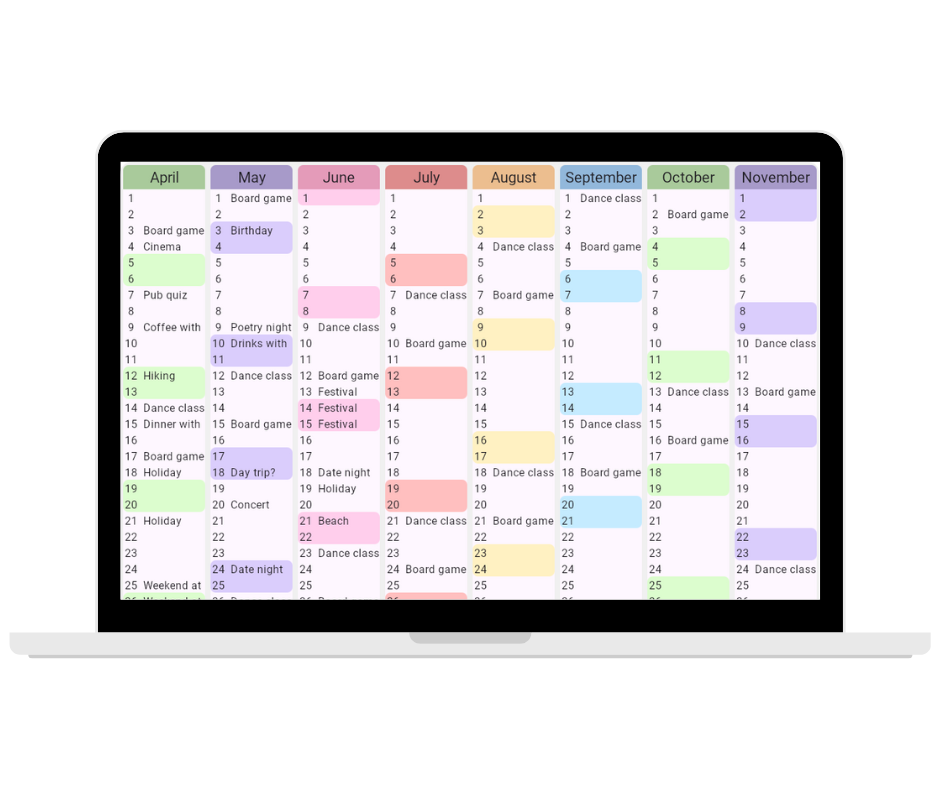
A few years ago, I had a list of goals that sounded amazing on paper:
📚 Read more books on business and productivity
✍️ Keep up a blog and social following
💻 Learn digital illustration
🎨 Paint watercolor
💪 Get into running and work up to a half-marathon
🗣️ Learn German
🎥 Start a Youtube channel
Every week, I’d try to chip away at all of them. A little bit here, a few pages there, maybe 20 minutes of tutorials squeezed between other things. But even on my most productive weeks, I’d barely manage to make real progress on any of them. And instead of feeling proud, I’d feel like I was failing.
At the time, I didn’t realize that the real problem wasn’t motivation – it was a lack of intentional time management.
And that’s the trap so many of us fall into.
We overestimate what we can do. We underestimate the power of focus. And we forget that saying yes to something means saying no to something else.
The paradox of choice and the gift of limits
I recently read a newsletter from Jonny Thomson quoting philosopher Oliver Burkeman, who puts it beautifully:
“Every moment that you’re trying to decide what to do with the next half hour… you’re confronting your limitations. The more consciously you do that, the more immersed you become in life. There’s freedom in coming back home to what it means to be finite.”
Burkeman and others talk about the ‘dizziness of freedom,’ sometimes called ‘the paradox of choice,’ which is when you believe you can do anything, try everything, be everywhere. And instead of feeling empowered, you end up paralyzed.
The irony is, the fewer paths you try to follow, the further you’ll go.
Choose what matters and give it space to grow
Now when I set goals, I choose one or two things that truly matter. Then I protect that space. Not just for the next week, but across the months ahead. I block time in my calendar for both recurring focus sessions and long-term milestones.
Sure, that means saying no to other things, but that’s the tradeoff of managing time intentionally. In return, I make meaningful progress on what matters most. And the process feels far more rewarding.
That shift in mindset is what led me to using a year-at-a-glance calendar – and eventually to helping my husband build Glance.
Because here’s the thing: most calendars are great at managing your week. But they’re not built to help you manage your year. And when you only see short-term slices of time, it’s easy to overcommit, under-focus, or push long-term goals indefinitely into “someday.”

When I can see the full year, I plan differently. I make space for what matters and I recognize where that space is already gone. It’s not just a calendar – it’s a tool for intentional time management.
Let’s say I decide to run a half-marathon in 1 year. A year, a full 12 months, can feel like a long time. But mapped across actual weeks, complete with training blocks, travel, holidays, and rest days, I can immediately see I need to start now if I’m going to make it happen.
That kind of long-term clarity makes it easier to say no to distractions. Not out of guilt but out of commitment. I’ve chosen this goal. It deserves my time.
Time isn’t infinite. When you can actually see it, you can use it with more intention.
The hard part: narrowing down your list
Of course, choosing just 1–3 priorities sounds simple in theory. In practice, it can feel almost impossible.
Letting go of things, even temporarily, can stir up guilt, FOMO, or a nagging sense that you’re abandoning part of your identity. Cutting that list down can feel like you’re betraying a part of yourself.
But here’s the shift that helped me: you’re not saying no forever. You’re saying not right now.
These opportunities don’t disappear just because they’re not in focus. They’re still yours. They’re just on the bench until the season changes. And once you’ve made real progress, or created space again, you can choose what to bring back in.
Another thing that’s helped: always leaving room for one “just for fun” thing. Something with no productivity angle. No monetization plan. No pressure to turn it into something bigger.
That hobby, whether it’s playing music, learning a language, painting, or gaming, isn’t a distraction from your goals. It’s a source of joy, and joy matters just as much as progress. These are often the activities that restore your energy, reconnect you with yourself, and make the rest of your focused time feel more sustainable.

So yes, narrowing down is hard. But it’s worth it. Because when you stop trying to do everything, you give yourself the chance to actually do something deeply and intentionally – and still enjoy life along the way.
You can only live one life. Live it intentionally.
I’ll leave you with this story from Thomson’s newsletter: He realized there are only 52 weekends in a year. Factor in holidays, birthdays, and the unexpected, and maybe 40 weekends are truly yours.
His takeaway? “I want to see fewer friends, more often.”
That kind of shift doesn’t happen by accident. It happens when you get honest about what matters and practice intentional time management with the time you actually have.
So no – you don’t have to do everything. You can’t, actually.
You just have to do the right things, deeply and intentionally.
And that starts with seeing your time clearly.
